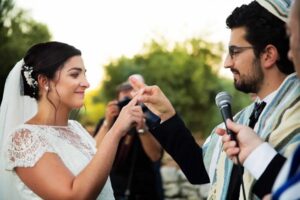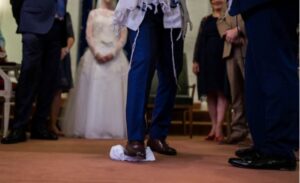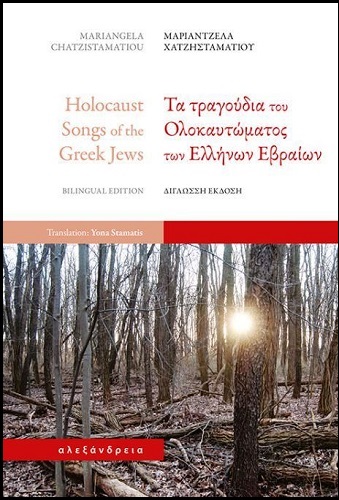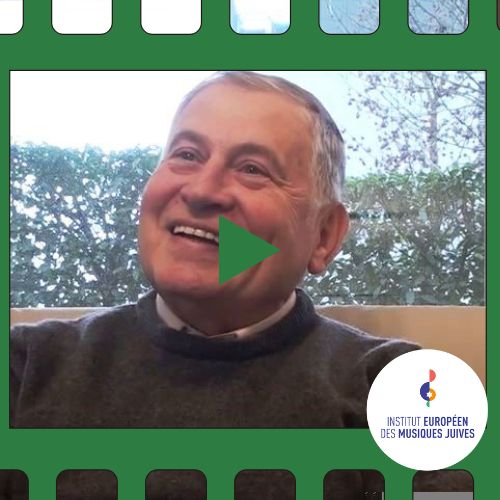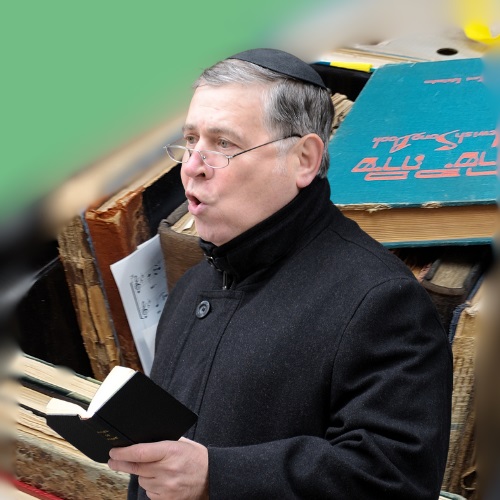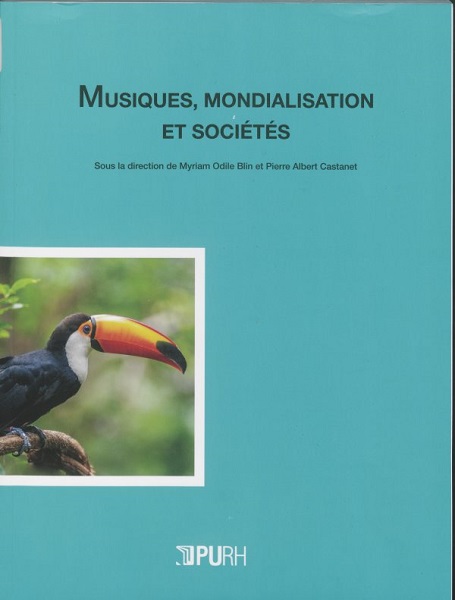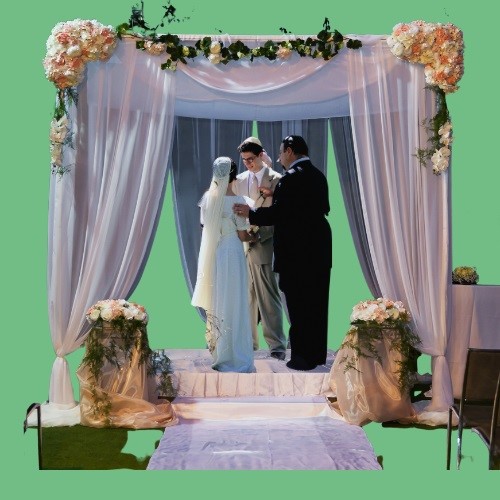
By Avner Azoulay
The Jewish wedding is celebrated according to numerous customs and laws designed to bring out its full spiritual and material significance. Using gestures, symbolism and Hebrew verses, all these rites express the profound meaning of the union of a man and a woman, including the establishment of a certain number of obligations that are automatically created between the spouses.
In France, Jewish marriages require a birth certificate, the parents’ marriage certificate (ketubah), the parents’ family record book (livret de famille) and the bride and groom’s family record book (livret de famille), to ensure that the marriage is legal.
In most Sephardic Jewish weddings, the wedding ceremony is preceded by a henna party.
Wedding customs
The wedding day is an extremely auspicious day to repent for past sins, so much so that some brides and grooms fast on their wedding day and read the prayer recited on Yom Kippur (Great Forgiveness) instead of the afternoon prayer normally recited every day of the year. Their sins are forgiven on this day, as a new life together begins, symbolizing the fact that their union is in some way the birth of a new soul through the fusion of their respective souls.
The bride and groom are considered to have the status of king and queen for a year, and especially for the seven days following the wedding. For this reason, they are forbidden to do any work whatsoever, and so relatives take advantage of the occasion to perform a good deed, like servants who cheerfully serve their king or queen: they dress the bride and groom before the ceremony, they invite the newlyweds to a banquet during the following seven days, and so on. The bride and groom are called khatan for the man and kala for the woman.
Jewish weddings are celebrated under the bridal canopy (chuppah). This symbolizes the new home which, according to the prophet Malachi, is called “a sanctuary for the Lord”.
The ritual
The ceremony proceeds as follows: the officiating rabbi stands under the bridal canopy, where the groom is invited to join him; the groom is usually accompanied by his parents. Finally, the bride is invited. She stops a few meters before the bridal canopy, and the groom comes down to place the veil over her face. This gesture symbolizes the groom’s verification that this is indeed his wife, and his covering of her face once he’s sure it’s the right one; it refers to Jacob’s first marriage, to which Laban deceitfully gave Leah instead of Rachel. Then the groom returns under the chuppah, followed by his bride-to-be.
The chanting of blessings
The officiating rabbi begins by filling a wine glass and reading the engagement blessings:
. בָּרוּךְ אַתָּה יְהוָה אֱלֹהֵינוּ מֶלֶךְ הָעוֹלָם, בּוֹרֵא פְּרִי הַגָּפֶן
בָּרוּךְ אַתָּה יְהוָה אֱלֹהֵינוּ מֶלֶךְ הָעוֹלָם, אֲשֶׁר קִדְּשָׁנוּ בְּמִצְוֹתָיו וְצִוָּנוּ עַל הָעֲרָיוֹת וְאָסַר לָנוּ אֶת־הָאֲרוּסוֹת, וְהִתִּיר לָנוּ אֶת־הַנְּשׂוּאוֹת לָנוּ עַל יְדֵי חֻפָּה בְקִדּוּשִׁין. בָּרוּךְ אַתָּה יְהֹוָה, מְקַדֵּשׁ עַמּוֹ יִשְׂרָאֵל עַל יְדֵי חֻפָּה בְקִדּוּשִׁין
Baroukh ata Adonaï Elohenou melekh ha-olam, bore peri hagefen.
Baroukh ata Adonaï Elohenou melekh ha-olam, acher kidechanou bemitsvotav vetsivanou al ha-arayot ve-asar lanou et ha-arousot, ve-hitir lanou et ha-netouot lanou al yede ḥoupa ve-kidouchin. Baroukh ata Adonaï, mekadech amo Yisrael al yede ḥoupa ve-kidouchin.
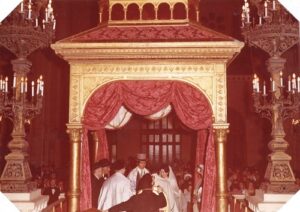
Praise be to you, Eternal One, our God, King of the Universe, who created the fruit of the vine.
Praise be to you, Eternal One, our God, King of the Universe, who has sanctified us with your commandments, and given us prescriptions concerning unions between close relatives, forbidding us the betrothals of others and allowing us unions consecrated by religious marriage. Blessed are you, Eternal One, who sanctifies your people Israel with the bridal canopy and the consecration of marriage.
Blessing of the engaged couple under the chuppah (Ashkenazi rite) – Jacques Arnold
Audio Player
The bride and groom then taste the wine. After this, the groom places a smooth, round gold ring on the first phalanx of the bride’s index finger, who then bends her finger. He then recites the following phrase:
: הֲרֵי אַתְּ מְקֻדֶּשֶׁת לִי בְּטַבַּעַת זוֹ כְּדַת מֹשֶׁה וְיִשְׂרָאֵל
Hare at mekoudechet li betabaat zo kedat Moche ve-Yisrael.
You are now sanctified to me by this ring, according to the law of Moses and Israel.
It’s a transaction: the man gives the woman a precious ring, and she accepts the gift, reserving herself for her husband, hence the term “ mekoudechet ” declared by the future husband at the same time, which in Hebrew means “consecrated” or “reserved”.
Today, as society and people’s minds have evolved, a woman may present her husband with a ring at the end of the ceremony.
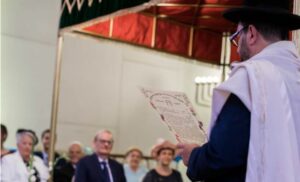
Next, the officiating rabbi reads the marriage certificate (the ketubah) in Aramaic. This document testifies to the man’s financial and material obligations to his wife.
The marriage contract (ketubah) must be signed not only by the officiating rabbi, but also by two witnesses who are not related to the bride and groom by blood. The marriage certificate is then given to the wife, who keeps it for the rest of her life.
The ceremony of the seven blessings
A second glass of wine is filled and the ceremony of the seven blessings (Sheva Berakhot) begins. Their meaning is the relationship between the bride and groom and the Almighty, and the joy that accompanies marriage.
1. The wine
.בָּרוּךְ אַתָּה יְיָ אֱ-לֹהֵינוּ מֶלֶךְ הָעוֹלָם, בּוֹרֵא פְּרִי הַגָּפֶן
Baroukh ata Adonaï Elohenou melekh ha-olam, bore peri hagefen.
Praise be to you, Eternal our God, King of the Universe, who created the fruit of the vine.
1st blessing (Ashkenazi rite) – Joseph Blumberg, accompanied on the organ by Alain Jehan, dir: Léon Algazi (Le chant hébraïque de la synagogue française, Ed. La Voix de Son Maître, 1933)
Audio Player
2. The goal
.בָּרוּךְ אַתָּה יְיָ אֱ-לֹהֵינוּ מֶלֶךְ הָעוֹלָם, שֶׁהַכֹּל בָּרָא לִכְבוֹדוֹ
Baroukh ata Adonaï Elohenou melekh ha-olam, chehakol bara likhvodo.
Praise be to you, Eternal our God, King of the Universe, who created everything for His glory.
2nd blessing (Ashkenazi rite) – Joseph Blumberg, accompanied on the organ by Alain Jehan, dir: Léon Algazi (Le chant hébraïque de la synagogue française, Ed. La Voix de Son Maître, 1933)
Audio Player
3. The man
.בָּרוּךְ אַתָּה יְיָ אֱ-לֹהֵינוּ מֶלֶךְ הָעוֹלָם, יוֹצֵר הָאָדָם
Baroukh ata Adonaï Elohenou melekh ha-olam, yotser ha-adam.
Be praised, Eternal our God, King of the Universe, Creator of man.
3rd blessing (Ashkenazi rite) – Joseph Blumberg, accompanied on the organ by Alain Jehan, dir: Léon Algazi (Le chant hébraïque de la synagogue française, Ed. La Voix de Son Maître, 1933)
Audio Player
4. The woman
בָּרוּךְ אַתָּה יְיָ אֱ-לֹהֵינוּ מֶלֶךְ הָעוֹלָם, אֲשֶׁר יָצַר אֶת הָאָדָם בְּצַלְמוֹ, בְּצֶלֶם דְּמוּת תַּבְנִיתוֹ, וְהִתְקִין לוֹ מִמֶּנּוּ בִּנְיַן עֲדֵי עַד: בָּרוּךְ אַתָּה יְיָ, יוֹצֵר הָאָדָם
Baroukh ata Adonaï Elohenou melekh ha-olam, acher yatsar et ha-adam betsalmo, betselem demout tavnito, vehitkin lo mimenou bintyan ade ad. Baroukh ata Adonaï, yotser ha-adam.
Praise be to the Lord our God, King of the Universe, who created man in His own image and made him a monument for all eternity. Be praised, Eternal creator of man.
4th blessing (Ashkenazi rite) – Joseph Blumberg, accompanied on the organ by Alain Jehan, dir: Léon Algazi (Le chant hébraïque de la synagogue française, Ed. La Voix de Son Maître, 1933)
Audio Player
5. Jerusalem
.שׂוֹשׂ תָּשִׂישׂ וְתָגֵל הָעֲקָרָה, בְּקִבּוּץ בָּנֶיהָ לְתוֹכָהּ בְּשִׂמְחָה: בָּרוּךְ אַתָּה יְיָ, מְשַׂמֵּחַ צִיּוֹן בְּבָנֶיהָ
Sos tasis ve-tagel ha-akara, bekibouts baneha letokhah besimḥa. Baroukh ata Adonaï mesameaḥ tsion bevaneha.
Zion will rejoice when the Lord gathers his children. Be praised, Eternal One, who makes Zion glad through her children.
5th blessing (Ashkenazi rite) – Joseph Blumberg, accompanied on the organ by Alain Jehan, dir: Léon Algazi (Le chant hébraïque de la synagogue française, Ed. La Voix de Son Maître, 1933)
Audio Player
6. Happiness
.שַׂמַּח תְּשַׂמַּח רֵעִים הָאֲהוּבִים, כְּשַׂמֵּחֲךָ יְצִירְךָ בְּגַן עֵֽדֶן מִקֶּֽדֶם: בָּרוּךְ אַתָּה יְיָ, מְשַׂמֵּֽחַ חָתָן וְכַלָּה
Samaḥ tesamaḥ reïm ha-ahouvim, kesameḥakha yetsirkha began eden mikedem. Baroukh ata Adonaï mesameaḥ ḥatan vekala.
May you bring joy to this beloved couple as you did to the creatures in the Garden of Eden, Praise be to you, Eternal One, who brings joy to both bride and groom.
6th blessing (Ashkenazi rite) – Joseph Blumberg, accompanied on the organ by Alain Jehan, dir: Léon Algazi (Le chant hébraïque de la synagogue française, Ed. La Voix de Son Maître, 1933)
Audio Player
7. Completeness and beyond
בָּרוּךְ אַתָּה יְיָ אֱ-לֹהֵינוּ מֶלֶךְ הָעוֹלָם, אֲשֶׁר בָּרָא שָׂשׂוֹן וְשִׂמְחָה, חָתָן וְכַלָּה, גִּילָה רִנָּה דִּיצָה וְחֶדְוָה, אַהֲבָה וְאַחֲוָה שָׁלוֹם וְרֵעוּת, מְהֵרָה יְיָ אֱ-לֹהֵינוּ יִשָּׁמַע בְּעָרֵי יְהוּדָה וּבְחוּצוֹת יְרוּשָׁלָיִם, קוֹל שָׂשׂוֹן וְקוֹל שִׂמְחָה, קוֹל חָתָן וְקוֹל כַּלָּה, קוֹל מִצְהֲלוֹת חֲתָנִים מֵחֻפָּתָם, וּנְעָרִים מִמִּשְׁתֵּה נְגִינָתָם: בָּרוּךְ אַתָּה יְיָ, מְשַׂמֵּחַ חָתָן עִם הַכַּלָּה
Baroukh ata Adonaï Elohenou melekh ha-olam, acher bara sason vesimḥa, ḥatan vekhala, gila rina ditsa veḥedva, ahava veaḥva chalom vereout. Mehera Adonaï Elohenou yichama beare Yehouda ouvḥoutsot Yerouchalayim, kol sason vekol simḥa, kol ḥatan vekol kala, kol mitzhalot ḥatanim meḥoupatam, ounarim mimichte neginatam. Baroukh ata Adonaï mesameaḥ ḥatan im ha-kala
Praise be to you, Eternal One, our God, King of the Universe, who created joy, gladness, the bridegroom, the bride, love and brotherhood, delights and pleasures, friendship and peace. O God, our God, may the voice of joy soon be heard in the cities of Judah and in the streets of Jerusalem, the voice of rejoicing that precedes the betrothed from their bridal canopy and the young men from their feasts full of song. Praise be to you, O Lord our God, King of the Universe, who makes the bridegroom and the bride happy and prosperous.
7th blessing (Ashkenazi rite) – Joseph Blumberg, accompanied on the organ by Alain Jehan, dir: Léon Algazi (Le chant hébraïque de la synagogue française, Ed. La Voix de Son Maître, 1933)
Audio Player
The couple then drink the wine from this second cup.
The closing of the wedding ceremony
The final stage of the ceremony is the breaking of the glass, a reminder of the destruction of the Temple of Jerusalem, and thus a sign that no joy can be complete until the Temple of Jerusalem is rebuilt.
The groom recites the following phrase from Psalm 137:
.אִם־אֶשְׁכָּחֵךְ יְרוּשָׁלָ͏ִם תִּשְׁכַּח יְמִינִי .תִּדְבַּק־לְשׁוֹנִי לְחִכִּי אִם־לֹא אֶזְכְּרֵכִי אִם־לֹא אַעֲלֶה אֶת־יְרוּשָׁלַ͏ִם עַל רֹאשׁ שִׂמְחָתִי
Im echkaḥekh Yerouchalayim tichkaḥ yemini. Tidbak lechoni leḥiki im lo ezkerekhi. Im lo aale et Yerouchalayim al roch simḥati.
If I forget thee, Jerusalem, let my right hand forget me. May my tongue stick to my palate if I do not recall your memory, if I do not raise Jerusalem above my joy.
The groom then breaks a glass with his foot, usually wrapped in a cloth to prevent splinters. The guests then shout in Hebrew “Mazel Tov!” (literally “good star”, in the sense of “best wishes”).
The reception and post-nuptial festivities
The newlyweds have a special obligation to rejoice. A reception therefore follows the ceremony, with a festive meal during which it is customary to eat bread and meat, accompanied by music and dancing.
After the meal, all the guests gather to recite thanksgiving (Birkat Hamazone). Afterwards, the seven blessings (Sheva Berakhoth) are again recited over a glass of wine. Similarly, for the seven days following the wedding, the bride and groom are invited each evening by their loved ones to a banquet in their honor, which is again followed by the recitation of the seven blessings.
Listen to the Traditional Jewish Wedding playlist (1)
Listen to the Traditional Jewish Wedding playlist (2)
